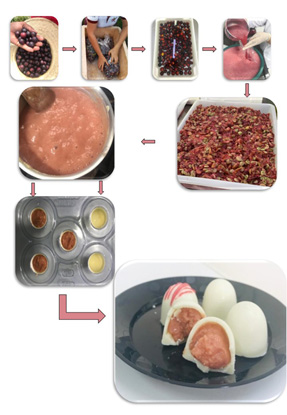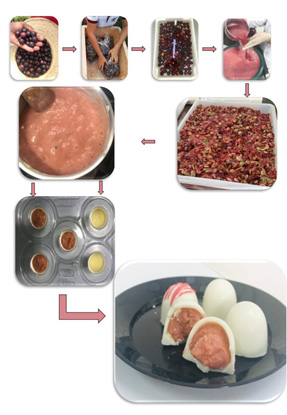Acceptability of bonbons made with camu-camu (Myrciaria dubia L)
DOI:
https://doi.org/10.48162/rev.39.161Palabras clave:
subproductos, propiedades funcionales, salud humana, potencial industrialResumen

The aim of this study was to formulate and evaluate different formulations of camu-camu bonbons, verifying which formulations obtained greater acceptability and maintenance of their nutraceutical potential. The bonbons were made of 2 chocolate-based toppings (white chocolate and milk chocolate), with three types of camu-camu-based fillings (candy, candy + jelly and candy + syrup). A sensory analysis was performed using a questionnaire and a hedonic scale ranging from 9 to 1 to evaluate appearance, colour, taste and texture. The hedonic scale used to assess purchase intentions ranged from 5 to 1. The physicochemical characteristics and bioactive compounds of the bonbons were evaluated. Bonbons had excellent acceptability rates, where consumers would definitely buy bonbons: white chocolate stuffed with camu-camu candy+camu-camu syrup (F3) and milk chocolate stuffed with camu-camu candy (F4). Consumers would ‘probably buy’ white chocolate stuffed with camu-camu candy (F1) based on its texture and high levels of vitamin C (VitC), antioxidant activity (FRAP) and (DPPH), phenolic compounds (Phen), and flavonoids (Flavon). Milk chocolate stuffed with camu-camu candy (F4), white chocolate stuffed with camu-camu candy+camu-camu syrup (F3), and white chocolate stuffed with camu-camu candy (F1) have excellent purchase percentages and levels of VitC, FRAP and DPPH, Phen, and Flavon, and especially titratable low acidity; these formulations are highlighted among consumers.
Highlights:
- Camu-camu bonbons have bioactive compounds and high nutraceutical potential.
- Different bonbon formulations affect the profile of bioactive compounds in bonbons.
- The different parts of the camu-camu fruit used in the bonbon’s formulation influence the nutraceutical potential of the products.
Descargas
Citas
AOAC. 2012. Official methods of analysis of AOAC International (A. international (ed.); 19th ed.). AOAC International. http://www.eoma.aoac.org/
Bataglion, G. A.; Silva, F. M. A.; Eberlin, M. N.; Koolen, H. H. F. 2015. Determination of the phenolic composition from Brazilian tropical fruits by UHPLC-MS/MS. Food Chemistry. 180: 280-287. https://doi.org/10.1016/j.foodchem.2015.02.059
Brand-Williams, W.; Cuvelier, M. E.; Berset, C. 1995. Use of a free radical method to evaluate antioxidant activity. LWT - Food Science and Technology. 28(1): 25-30. https://doi. org/10.1016/S0023-6438(95)80008-5
Chagas, E. A.; Lozano, R. M. B.; Chagas, P. C.; Bacelar-Lima, C. G.; Garcia, M. I. R.; Oliveira, J. V.; Souza, O. M.; Morais, B. S.; Araújo, M. C. R. 2015. Intraspecific variability of camu-camu fruit in native populations of northern Amazonia. Crop Breeding and Applied Biotechnology. 15(4): 265-271. https://doi.org/10.1590/1984-70332015v15n4a44
Chirinos, R.; Galarza, J.; Betalleluz-Pallardel, I.; Pedreschi, R.; Campos, D. 2010. Antioxidant compounds and antioxidant capacity of Peruvian camu camu (Myrciaria dubia (H.B.K.) McVaugh) fruit at different maturity stages. Food Chemistry. 120(4): 1019-1024. https:// doi.org/10.1016/j.foodchem.2009.11.041
Conceição, N.; Albuquerque, B. R.; Pereira, C.; Corrêa, R. C. G.; Lopes, C. B.; Calhelha, R. C.; Alves, M. J.; Barros, L. C. F. R.; Ferreira, I. 2019. By-Products of Camu-Camu [Myrciaria dubia (Kunth) McVaugh] as promising sources of bioactive high added-value food ingredients: Functionalization of yogurts. Molecules. 25(1): 70. https://doi.org/10.3390/ molecules25010070
Costa, J. N.; Brito, S. A.; Leal, A. R.; Rodrigues, D. C.; Nascimento, L. G. L.; Figueiredo, R. W.; Mata, P.; Sousa, P. H. M. 2020. Sensory characteristics of structured guava (Psidium guajava): Comparison of optimized descriptive profile, cata and sensory acceptance methods. Food Science and Technology. 40: 496-502. https://doi.org/10.1590/fst.25819
Cruz, L. M.; Guimarães, R. C. A. 2020. Controle de qualidade de bombom funcional acrescido de biomassa de banana-verde e geleia de pitanga. Multitemas. 25(60): 163-180. https://doi. org/10.20435/multi.v0i_.1808
Delgado-Nieblas, C. I.; Zazueta-Morales, J. J.; Aguilar-Palazuelos, E.; Jacobo-Valenzuela, N.; Aguirre-Tostado, F. S.; Carrillo-López, A.; Ruiz-Armenta, X. A.; Telis-Romero, J. 2018. Physical, microstructural and sensory characteristics of extruded and microwave-expanded snacks added with dehydrated squash. Revista Mexicana de Ingeniera Química. 17(3): 805-821. https://doi.org/10.24275/uam/izt/dcbi/revmexingquim/2018v17n3/Delgado
Dessimoni-Pinto, N. A. V.; Moreira, W. A.; Cardoso, L. M.; Pantoja, L. A. 2011. Aproveitamento tecnológico da casca de jabuticaba para elaboração de geléia. Ciencia e Tecnologia de Alimentos. 31(4): 864-869. https://doi.org/10.1590/S0101-20612011000400006
Dutcosky, S. D. 1996. Análise sensorial de alimentos. (Dutcosky, S. D. 2019. Análise sensorial de alimentos. Curitiba: PUCPRESS. 5ª ed. 540 p.).
Falcão, A. P.; Chaves, E. S.; Kuskoski, E. M.; Fett, R.; Falcão, L. D.; Bordignon-Luiz, M. T. 2007. Índice de polifenóis, antocianinas totais e atividade antioxidante de um sistema modelo de geléia de uvas. Ciencia e Tecnologia de Alimentos. 27(3): 637-642. https://doi.org/10.1590/ S0101-20612007000300032
Fidelis, M.; Moura, C.; Kabbas, T.; Pap, N.; Mattila, P.; Mäkinen, S.; Putnik, P.; Kovačević, D. B.; Tian, Y.; Yang, B.; Granato, D. 2019. Fruit seeds as sources of bioactive compounds: Sustainable production of high value-added ingredients from by-products within circular economy. Molecules. 24(21): 38-54. https://doi.org/10.3390/molecules24213854
Grigio, M. L.; Chagas, E. A.; Durigan, M. F. B.; Sousa, A. A.; Mota Filho, A. B.; Chagas, P. C. 2016. Determination of harvest time and quality of native camu-camu fruits (Myrciaria dubia (Kunth) Mc Vaugh) during storage. Fruits. 71(6): 373-378. https://doi.org/10.1051/ fruits/2016029
Grigio, M. L.; Durigan, M. F. B.; Chagas, E. A. 2019. Different formulations of camu-camu popsicle: characterization, vitamin C and sensorial analysis of an opportunity to family agroindustry. Food Science and Technology. 39(suppl 1): 93-97. https://doi.org/10.1590/fst.38417
Grigio, M. L.; Moura, E. A.; Carvalho, G. F.; Zanchetta, J. J.; Chagas, P. C.; Chagas, E. A.; Durigan, M. F. B. 2021a. Nutraceutical potential, qualitative and acceptability of different camu‐camu popsicle. Journal of Food Processing and Preservation, 45(3). https://doi.org/10.1111/jfpp.15305
Grigio, M. L.; Moura, E. A.; Carvalho, G. F.; Zanchetta, J. J.; Chagas, P. C.; Chagas, E. A.; Duringan, M. F. B. 2021b. Nutraceutical potential, quality and sensory evaluation of camu-camu pure and mixed jelly. Food Science and Technology. 41. https://doi.org/10.1590/fst.03421
Grigio, M. L.; Moura, E. A.; Chagas, E. A.; Durigan, M. F. B.; Chagas, P. C.; Carvalho, G. F.; Zanchetta, J. J. 2021c. Bioactive compounds in and antioxidant activity of camu-camu fruits harvested at different maturation stages during postharvest storage. Acta Scientiarum. Agronomy. 43(1): e50997. https://doi.org/10.4025/actasciagron.v43i1.50997
Guterres, A. S.; Araújo, S. H. A. 2019. Análise microbiológica e aceitabilidade de brigadeiro de biomassa de banana verde com recheio de cupuaçu. Nutrição Brasil. 18(2): 68-72. https:// doi.org/10.33233/NB.V18I2.2322
Lees, D. H.; Francis, F. J. 1972. Standardization of pigment analyses in cranberries. Hortscience.
Medeiros, M. J. M.; Silva, J. F.; Faustino, M. V. S.; Santos, M. F. G.; Rocha, L. C. S.; Carneiro, L. C. 2012. Aceitação sensorial e qualidade microbiológica de trufas de caju obtidas artesanalmente. Holos. 2(0): 77-86. https://doi.org/10.15628/HOLOS.2012.650
Nascimento, R. Q.; Tavares, P. P. L. G.; Meireles, S.; Anjos, E. A.; Andrade, R. B.; Machado, B. A. S.; Souza, A. L. C.; Mamede, M. E. O. 2020. Study on the sensory acceptance and check all that apply of mixed juices in distinct brazilian regions. Food Science and Technology. 40: 708-717. https://doi.org/10.1590/fst.37619
Peuckert, Y.; Viera, V.; Hecktheuer, L.; Marques, C.; Rosa, C. 2010. Caracterização e aceitabilidade de barras de cereais adicionadas de proteína texturizada de soja e camu-camu (Myrciaria dúbia). Alimentos e Nutrição. 21(1): 147-152.
Pinto, P. M.; Jacomino, A. P.; Silva, S. R.; Andrade, C. A. W. 2013. Ponto de colheita e maturação de frutos de camu-camu colhidos em diferentes estádios. Pesquisa Agropecuária Brasileira. 48(6): 605-612. https://doi.org/10.1590/S0100-204X2013000600005
R Core Team. 2020. R: A Language and Environment for Statistical Computing. https://www.r-project.org/
Ranganna, S. 1986. Handbook of analysis and quality control for fruit and vegetable products (2nd ed.). Tata McGraw-Hill.
Richter, M.; Lannes, S. C. D. S. 2007. Bombom para dietas especiais: Avaliação química e sensorial. Ciencia e Tecnologia de Alimentos. 27(1): 193-200. https://doi.org/10.1590/s0101- 20612007000100034
Rodrigues Gomes, F.; Morais Silveira, K.; Marques Rodrigues, C. D.; Alves Ferreira, B.; Lopes Barros, Â.; Hurtado Salazar, A.; Pereira da Silva, D. F.; Nunes da Silveira Neto, A. 2023. Correlations between physical and chemical characteristics of Cortibel guava (Psidium guajava L.) fruits grown in the Brazilian Cerrado. Revista de la Facultad de Ciencias Agrarias. Universidad Nacional de Cuyo. Mendoza. Argentina. 55(1): 10-16. DOI: https://doi.org/10.48162/rev.39.091
Rufino, M. S. M.; Alves, R. E.; Sousa Brito, E.; Morais, S. M.; Goes Sampaio, C.; Pérez-Jiménez, J.; Saura-Calixto, F. 2006. Metodologia científica: determinação da atividade antioxidante total em frutas pelo método de redução do ferro (FRAP). Comunicado Técnico, Embrapa Agroindústria Tropical, 4. https://ainfo.cnptia.embrapa.br/digital/bitstream/ CNPAT-2010/11964/1/cot-125.pdf
Silva, P. R. A.; Damy-Benedetti, P. C. 2018. Desenvolvimento e aceitação de bolinho integral de aveia com recheio de brigadeiro de Açaí. Revista Científica. 1(1). http://revistas.unilago.edu.br/ index.php/revista-cientifica/article/view/96
Singleton, V. L.; Orthofer, R.; Lamuela-Raventós, R. M. 1999. Analysis of total phenols and other oxidation substrates and antioxidants by means of folin-ciocalteu reagent. Methods in Enzymology. 299: 152-178. https://doi.org/10.1016/S0076-6879(99)99017-1
Sousa, C. L.; Lourenço, L. F. H.; Francês, J. M. O.; Soares, Y. P. P.; Araújo, E. A. F.; Pena, R. S. 2010. Avaliação microbiológica, físico-química e das condições de fabricação de bombom de chocolate com recheio de frutas. Alimentos e Nutrição Araraquara. 21(2): 305-310.
Sousa, G. G.; Viana, T. V. A.; Pereira, E. D.; Albuquerque, A. H. P.; Marinho, A. B.; Azevedo, B. M. 2014. Fertirrigação potássica na cultura do morango no litoral Cearense. Bragantia. 73(1): 39-44. https://doi.org/10.1590/brag.2014.006
Zhishen, J.; Mengcheng, T.; Jianming, W. 1999. The determination of flavonoid contents in mulberry and their scavenging effects on superoxide radicals. Food Chemistry. 64(4): 555-559. https://doi.org/10.1016/S0308-8146(98)00102-2

Descargas
Publicado
Cómo citar
Número
Sección
Licencia
Derechos de autor 2018 Revista de la Facultad de Ciencias Agrarias UNCuyo

Esta obra está bajo una licencia internacional Creative Commons Reconocimiento-NoComercial-CompartirIgual 3.0.
Aquellos autores/as que tengan publicaciones con esta revista, aceptan las Políticas Editoriales.










.jpg)




